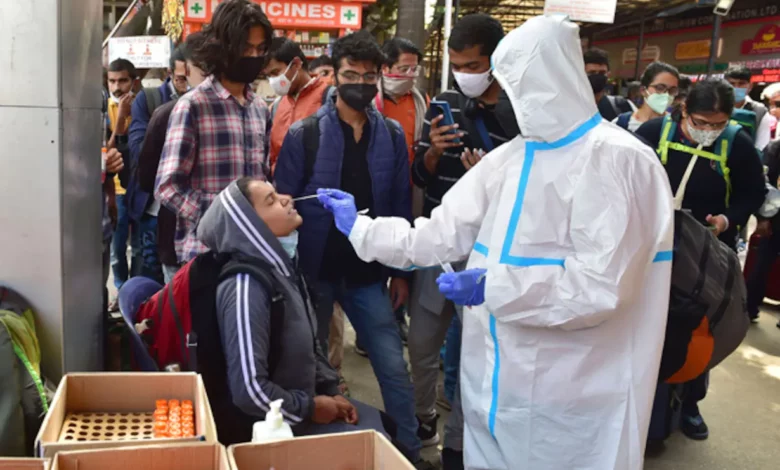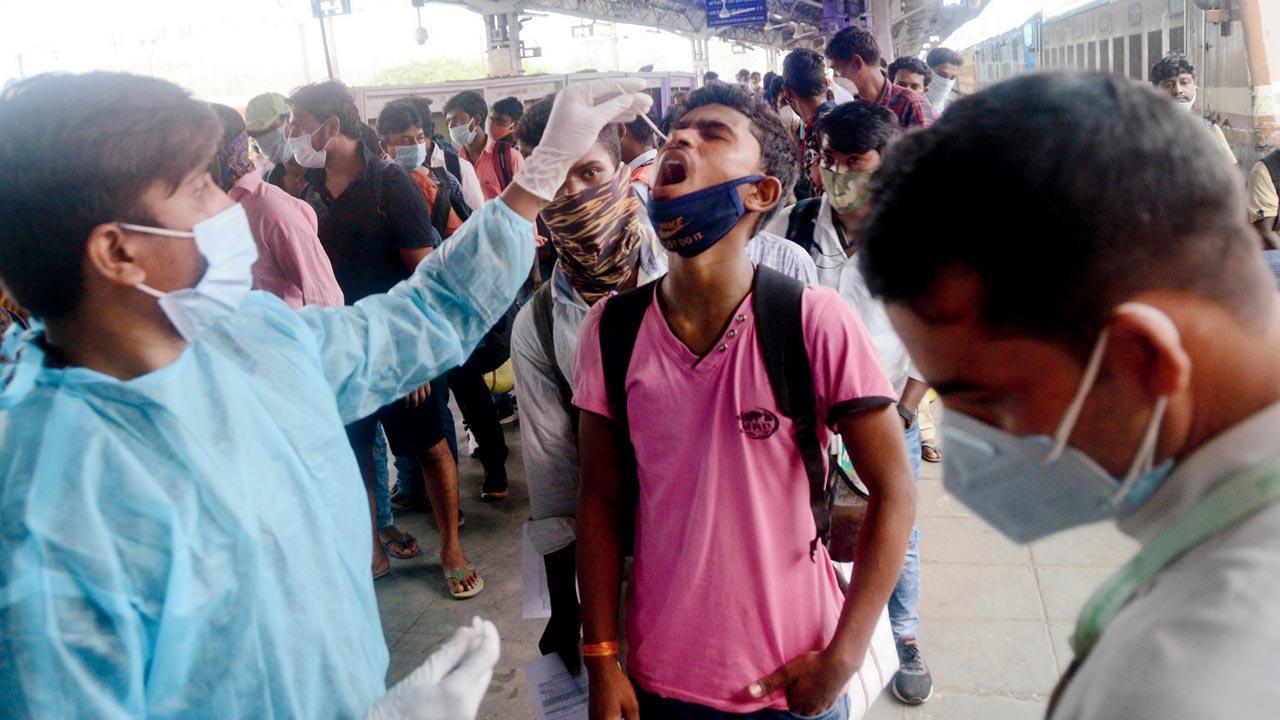India reports 2,183 new SARS-CoV-2 infections, a 90 per cent increase in daily Covid cases in the country and symptoms to Look Out For If You’re Afraid Of The XE Variant.

The Daily Covid Count in India has increased by 90%. There are 2,183 new cases in the pipeline. Today’s case count of 2,183 new Covid points is up 89.8% over yesterday’s 1,150 cases.
The daily Covid figures in India have risen sharply today, raising fears of yet another outbreak. A total of 2,183 new Covid cases have been documented in the last 24 hours, an increase of 89.8% from yesterday’s case total of 1,150 instances.
There have been 214 deaths in the last 24 hours. Kerala, on the other hand, has a backlog of 212 deaths, of which 62 have been cleared owing to legal challenges, despite the fact that the state reported 150 deaths between April 13 and April 16.
The daily death toll has also skyrocketed to 214. Despite the fact that the death toll includes 62 dead from Kerala, it is still a huge increase over the four deaths recorded in yesterday’s briefing.
The daily positivity rate has increased from 0.31 percent yesterday to 0.83 percent today, showing that the virus is spreading widely.
The number of active cases, however, has declined somewhat, from 11,558 to 11,542. The government has recorded around 4.30 crore cases since the outbreak began.
The national capital, Delhi, has 517 Covid incidences, making it one of the cities with the most. According to reports from yesterday, the total number of Covid-infected patients in Delhi has risen to 1,518, the highest level since March 3.
In recent weeks, several young people in Delhi and the neighbouring cities of Ghaziabad and Noida have tested positive, sparking panic and school closures.
Cases all around India

Following an 11-week reduction, Covid-19 instances in India spiked again this week, increasing by 35% over the previous seven days’ figures, owing to an outbreak in the adjacent states of Delhi, Haryana, and Uttar Pradesh.
However, total case numbers remain modest, and the outbreak appears to be limited to three states thus far. According to the Covid database, India registered roughly 6,610 new cases in the week ending Sunday (April 11-17), up from 4,900 in the preceding seven days.
Although there were about 7,010 cases reported the previous week, Kerala’s cases have been subtracted from the total for comparative purposes because the state has discontinued issuing Covid statistics this week.
Kerala had 2,185 cases reported last week (April 4-10), accounting for over a third of the national total.
Virus-related deaths in the country continue to drop, with only 27 new fatalities reported last week, the fewest in almost two years since March 23-29, 2020. Last week, 54 people died, with 13 of them in Kerala.
New cases in all three states that have seen increased infections have more than doubled in the last week. With 2,307 new cases, Delhi significantly outpaced the rest of the country, up 145 per cent over the previous week’s total of 943. Moreover, a third of all cases reported in the country were in the capital.
Weekly cases in Haryana increased by 118 per cent from the previous week’s tally of 514 to 1,119. Uttar Pradesh saw a 141 per cent increase in instances this week, with 540 cases compared to 224 the week before. Most new cases in both states were reported in Delhi’s NCR cities, such as Gurgaon, Noida, and Ghaziabad.
Weekly cases remained relatively stable in Karnataka, Tamil Nadu, Gujarat, and Rajasthan. The surge in instances recorded last week in Gujarat appears to have subsided, with 110 cases reported this week compared to 115 the week before. Rajasthan had a slight increase in cases, from 67 to 90, while the numbers were still too low to be alarming.
Weekly incidences throughout the country have gradually reduced since the peak of the third wave on January 17-23. Despite the recent surge in infections, India’s overall Covid statistics are similar to those seen nearly two years ago, during the first weeks of the nationwide lockdown.
The number of active virus cases in the country was over 12,000 last week, up roughly 1,000 from the previous week due to a surge in the three northern states.
Fears about the Covid fourth wave

The increase in Delhi and Haryana cases has rekindled fears that the country is entering the fourth wave. However, predicting anything about a new wave of illnesses is risky. The virus’s evolution is an entirely random and unpredictable process. And it appears that a new wave of infections in India will be triggered solely by the development of a new variation. This is due mainly because the majority of India’s population has already been infected with the Omicron strain, and the population is believed to have developed some immunity to it.
Reinfection with the same variation is not uncommon, but it is not shared.
It’s unclear how long the immunity developed from a previous illness will last. According to current estimates, it’s expected to continue for at least six to nine months. This is also the nine-month delay in delivering vaccine booster doses. Most patients infected with the Omicron type during the third wave would have adequate protection for at least a few months. As a result, fears that this marks the start of the fourth wave may be unfounded for the time being unless a new harmful variation is discovered in the population, of course.
“We’re in a good spot. We have an excellent vaccination rate, something the government should be proud of. We also have a high infection rate in public, which we picked up through numerous waves, “Dr Gagandeep Kang, one of India’s leading virologists, agrees.
Second, an easily spread sub-variant of Omicron known as BA.2 is causing an increase in cases in Europe and abroad. BA.2 – a virus that is better able to avoid the vaccine – was already the dominant strain fueling the country’s Omicron surge, according to Indian scientists sampling sequences in February.
In another way, India’s BA.2-fueled tidal wave appears to be over. “The chances of a large-scale nationwide outbreak of diseases in India in the foreseeable future are quite remote,” says physician epidemiologist Dr Chandrakant Lahariya.
Isn’t it true, though, that immunity fades over time?

Yes, it does. However, other studies suggest that three doses of vaccination can help patients avoid severe disease and death for a long time.
Booster shots help the body produce more neutralizing antibodies, an essential part of our immunological defences. Since January, India has given out more than 20 million booster vaccine doses, dubbed “precaution doses”, by the Indian government.
People over 60 years old with comorbidities and health and frontline professionals are currently eligible for the booster shot.
Despite this, India has yet to declare a policy extending boosters to those under 60. This isn’t because there aren’t enough doses. The world’s largest vaccine manufacturer, Serum Institute of India, claims to have 200 million doses of Covishield on hand. This vaccination is the most widely utilized in India, accounting for more than 80% of all doses delivered. Covishield is mainly given as a third dosage because the government has chosen that the booster will be the same vaccination given to a person for their first and second doses.
Therein lays a portion of the issue. According to virologist Shahid Jameel, India is “ignorant of the science underpinning booster doses.”
The best boosters available, he argues, are mRNA vaccines like Pfizer-BioNTech or Moderna, which use bits of genetic code to elicit an immune response, followed by a protein-based vaccine-like Novavax. In India, mRNA vaccinations are still unavailable. However, Serum Institute is producing Covovax, a local equivalent of Novavax that has already exported 40 million doses.
“Why isn’t it approved for use as a booster in India? Shouldn’t Indians have access to the most acceptable option? “Dr Jameel enquiries. A booster approach must be informed by data that shows when vaccine protection begins to diminish in various age groups.
The Centers for Disease Control and Prevention in the United States, for example, provides specific standards on who can get a booster dose and when and which vaccination can be used.
India has licensed nine Covid vaccines, five of which are manufactured. Only two have been primarily used.
“Rather than focusing on a program that provides people another dose of the same vaccine they already have,” Dr Kang adds, “India could investigate and figure out when the optimal time is to offer boosters and which vaccines would function best as boosters.”
So far, 637 persons in the United Kingdom have been infected with the XE strain. There have been no new cases of XE infection reported.
What is the current state of COVID?

Following Omicron Edition’s significant COVID rise, there has been a drop in instances in India and worldwide. However, several other varieties have already been discovered, including BA.4 and BA.5. Recombinant viruses such as XE, XF, and XD are also increasing over the world.
In addition, several areas are witnessing a minor increase in cases after a considerable decline in daily infections.
Meanwhile, WHO Director-General Tedros Adhanom Ghebreyesus warned that the pandemic is still ongoing, adding, “This virus has become more contagious over time and is extremely lethal for weak and uninfected people.”
“people who do not have access to medical care or antiviral medications”
Symptoms to look out for if you’re worried about the XE version

COVID symptoms differ from person to person, and it’s critical to understand them so that the infection’s severity can be minimized. While the coronavirus has a moderate effect on many people, it causes mayhem in others. As a result, it’s critical to understand the infection’s symptoms, even if they don’t appear to be typical.
Despite a drop in COVID cases and related fatalities, the World Health Organization (WHO) confirmed that coronavirus remains a severe public health threat. Meanwhile, incidents in other Indian states, notably Delhi-NCR and Gujarat, are rising. Even though there are no grounds to fear, experts warn that now is not the time to relax.
Brain fog
Brain fog is a disorder in which a person’s thinking becomes sluggish. It is most commonly found in COVID patients. The individual’s ability to think appears to have deteriorated. According to Harvard Medical School research, “brain fog is not a medical or scientific phrase; individuals use it to describe how they feel when their thinking is slow, foggy, and not sharp.”
Delirium
Research investigations have found a relationship between COVID infection and the risk of delirium. According to a study, 20-30% of COVID patients admitted to the hospital were prone to developing a fever. According to a health journal report, delirium remained unreported in early occurrences, partially because some coronavirus patients were under the effect of sedatives.
According to scientists, one of the main reasons why few people have delirium after contracting COVID is that the body’s immune system may have overreacted to the virus, limiting blood flow to the brain.
Confusion
This is listed as a potential COVID symptom by the US CDC. According to specialists, mental bewilderment and disorientation may be early indicators of severe COVID. According to a University of Florida study, those who displayed symptoms of disorientation were three times more likely than others to have severe COVID.
Palpitation
Another COVID symptom can be confused with those of various health problems. While many people dismiss palpitations as something that would pass in time, if it frequently occurs during COVID, it is essential to seek medical advice. This panic button should never be disregarded in the case of most heart diseases.
Irritation and discolouration of the skin
Many COVID patients have reported rashes and hives, and other investigations have verified that COVID harms many people’s skin.
Government health bodies have also proved COVID’s effect on skin, lips, and nails. “Pale, grey, or blue-colored skin, lips, or nail beds, depending on skin tone” is a probable COVID symptom and emergency warning sign, according to the US Centers for Disease Control and Prevention (CDC).
Neuropathy of the vocal cords
Vocal cord mobility has been linked to COVID infection in studies. “Laryngeal nerve palsies may be part of the COVID-19 neurologic spectrum,” says one researcher.
According to a study, vocal cord paralysis due to peripheral nerve injury-induced by the SARS-CoV-2 should be addressed when patients’ voices alter during COVID 19 infection.
During COVID, damage to the vagus nerve, which governs voice, swallowing, breathing, and coughing, is possible. Dr Jonathan Aviv, an ear, nose, and throat specialist at Mount Sinai Hospital in New York City, told a health journal, “If the vagus has been towel-snapped by a virus, it will not function correctly, and one of the indications is shortness of breath with or without cough.”
Fever
Fever and indications of fever should not be overlooked three years into the pandemic. A spike in body temperature should not be left to fall on its own; it must be handled.
Fever (a high temperature) is a common symptom of COVID-19, according to the ZOE COVID app, affecting more than two-thirds of those infected. If your body temperature rises above 37.8 degrees Celsius, get medical help.
Hypoxia
Hypoxia is a state in which there is insufficient oxygen at the tissue level to sustain proper homeostasis.
This condition has been discovered in a large number of COVID patients. Experts have dubbed it “happy hypoxia” because it isn’t severe except clinically. COVID patients have a common symptom of low blood oxygen levels, leading to coma, yet they are awake and show no other signs.
Distress in the digestive system
A minor change in the body is likely to impact intestinal health. People typically have gastrointestinal disorders and related concerns such as loss of appetite, nausea, and diarrhoea.
According to a Stanford Medicine study of 116 COVID infected people, about one-third developed digestive problems.
Taste and olfactory loss
This is a classic COVID symptom. During the second wave of COVID, spearheaded by the Delta strain, many people reported losing their sense of taste and smell. This symptom was not present during the third COVID wave, which Omicron led.
However, this symptom continues to entice researchers. For months at a time, people lose their sense of smell and taste. After over an hour, several people had regained their sense of smell and taste.
So, how about in the not-too-distant future?

Living with the virus in densely populated nations like India is only conceivable if most people have some level of protection against severe infections due to previous disease or immunization, which Indians appear to have.
“As a result, we can expect intermittent outbreaks and small rises in cases, rather than broad and alarming waves,” Dr Kamil explains.
The old and fragile, who might contract the virus multiple times despite immunization and develop more severe symptoms, must exercise extreme caution as immunity fades. India has a younger population with a high prevalence of diabetes and cardio-pulmonary disorders. They both require a boost.
In addition, epidemiologists like Dr Kang believe that India has to sequence more samples and do it quickly.
“India does not have enough samples to sequence. It’s a significant chink in our armour “.
According to Dr Reddy, because Covid appears to spread more quickly indoors than outdoors, India’s congested and poorly ventilated workplaces should embrace hybrid working and ensure that employees wear masks. Employers should pay for booster doses when vaccinations are offered privately.
“Everything should be manageable. When spikes or waves occur, we should not become immobile. However, we should use common sense precautions like wearing masks and avoiding needless social events “he continues.




